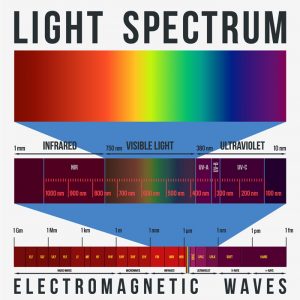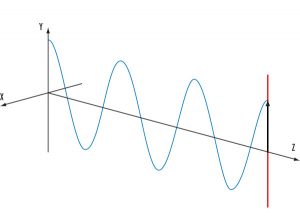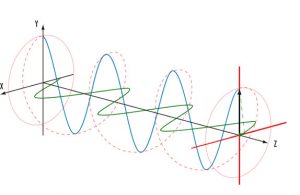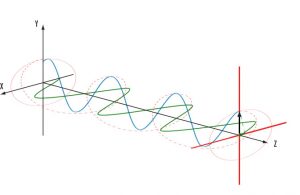

Light as Electromagnetic Waves
An electromagnetic wave is a transverse wave consisting of an electric field wave oscillating in a plane perpendicular to a magnetic field wave, both of which are perpendicular to the direction of motion. Since electromagnetic radiation acts as a wave, then any particular electromagnetic wave or light wave will have a frequency and wavelength associated with it. The product of the wavelength and frequency is the wave speed.
However, electromagnetic waves do not require a medium through which to propagate, and hence can traverse the vacuum of empty space. Electromagnetic waves come in many varieties, including radio waves, microwaves, infrared radiation, visible light, ultraviolet radiation, x-rays, and gamma rays.
In addition, since an electromagnetic wave is transverse with amplitude perpendicular to the direction of motion, it can be polarized – there are many possible planes perpendicular to the direction of motion, but a polarized wave will have transverse amplitude in only one of them. Longitudinal waves such as sound waves only have displacement in the direction of motion, and therefore they cannot be polarized.
Polarization, in terms of light, refers to the process of orienting or filtering light waves in a single direction, which affects what you can see.
Polarization of Light
Unpolarized light waves have multiple superimposed orientations. Light waves have both electric and magnetic fields, always at right angles to each other – by convention, polarization is defined by the direction of the electric field. Looking head on, we might see the electric field vectors pointing in all different directions.
When light is passed through a polarizer or polarizing filter, the filter lets only the portion of light with electric field lines oriented parallel to the filter to pass through. As a result, the light becomes polarized – all of it oriented in the same direction. This is linear polarization.

Light coming from light bulbs or the sun is not polarized. The most common sources of polarized light are lasers. If two polarizing filters are held at right angles to each other in front of an incident light source, all of the light will be blocked. If the angle is smaller only some of the light is blocked.
Light polarizers come in three types: reflective, dichroic and birefringent. Reflective polarizers only allow a certain polarization of light to pass through, while reflecting the rest; dichroic polarizers do the opposite, only blocking a certain polarization of light while allowing all others to pass through. In birefringence, different polarizations of light will refract at different angles, allowing for different polarizations of light to be selected depending on what polarization is desired.
Light polarization is how movies are projected in 3D. The 3D glasses given to movie-goers actually have opposite polarizing filters in each lens; a horizontal filter in the left and a vertical filter in the right, for example. The movie is then projected onto the same screen from two different projectors, one projecting light polarized vertically and one projecting light polarized horizontally. The left eye then sees a slightly different image than the right eye, and the brain combines the images to create a perception of depth.
Brewster's Angle and Polarization by Reflection
When a light beam is incident on a surface of a material, some of the light is reflected and some of it is refracted. The angle of incident light required for the reflected light and refracted light to be at an exact right angle is called Brewster's angle.
When the angle of incidence is equal to Brewster's angle, and the incident light is unpolarized, it will cause linear polarization of the reflected light. If the incident light has a specific polarization, particular to the material, it will only be refracted with no reflected light at all.
Why does this happen? When the incident light is temporarily absorbed by the atoms in the surface of the material, the electrons in the material's atoms oscillate. Because light waves are transverse, the polarization has to be perpendicular to the direction of motion of the wave. So if the polarization of the incident wave is in the direction that the reflected wave should be, the reflected wave can't exist.
If the incident light is unpolarized, the reflected light will be polarized horizontally, parallel to the reflecting surface. This is called s-polarized light. Light with polarization in the plane of incidence, or the plane formed from the direction of motion of the incident light and a vector perpendicular to the surface, is called p-polarized.
Polarized sunglasses use the concept of Brewster's angle to reduce sunlight reflection off of horizontal surfaces. When the sun is low in the sky, there is a lot of s-polarized light in reflected glare off of surfaces like water and roads. Polarized sunglasses block light having this polarization, reducing glare.
Polarization by Scattering
The scattering of incident light off of air molecules causes light to be linearly polarized perpendicular to the plane of incidence. Air molecules carry their own little oscillation in one direction, known as a dipole moment, and they radiate energy perpendicular to the line of that oscillation. So if a molecule's dipole moment oscillates back and forth on the y-axis, incident unpolarized light will scatter off of it in the x-direction, polarized in the y-direction.
If the wavelength of the incident light is comparable to the size of the molecules, this is called Rayleigh scattering. Rayleigh scattering is responsible for the color of the sky, whether it is a deep blue of a beautiful day or the deep red of a sunset; the colors change depending on the angle of incidence of sunlight on the atmosphere.
Polarization by Refraction
Polarization can also occur by the refraction, or bending of light as it passes from one medium into another. Most often, the polarization occurs perpendicular to the surface.
When a material's refractive index depends on the incident direction and polarization of the light, it is called birefringent. In birefringent materials, an incident ray of light is split by polarization into two rays inside the material, which take slightly different paths.
Some scientists suspect that a birefringent type of crystal called "calcite" may have been used by the Vikings as a navigational aid, as its refractive polarizing properties could be used to locate the sun on a cloudy day, or even below the horizon.
Circular Polarization
Circular polarization is a polarization state in which the direction of the electric field rotates circularly with time at a steady rate in a plane perpendicular to the direction of propagation. This can be imagined as the electric field vector drawing out a helix around the axis of propagation as the wave propagates.

If, while looking in the direction of the light source, the electric field vector appears to be rotating counterclockwise, the light is called right-circularly polarized. If the vector appears to be rotating clockwise, the light is called left-circularly polarized.
Circular polarization is created by two linearly polarized light waves, polarized perpendicular to each other, and each propagating 90 degrees out of phase. Elliptical polarization is when one of these light waves has a smaller amplitude than the other, creating an ellipse rather than a circle.
